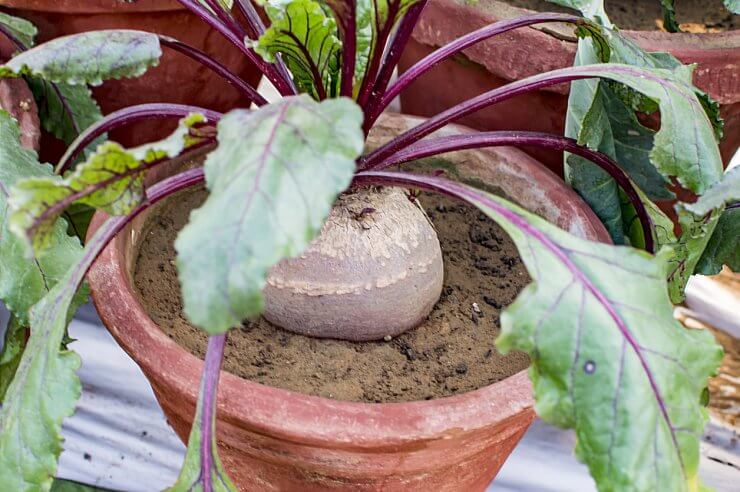
Beetroot plant growing in pot
Beets are easy to grow in containers. Give each seedling about 4 inches of space. You can plant your seeds in rows or in concentric circles. Make sure the soil is at least a foot deep and one to two feet across. And look for varieties that can do especially well in containers, such as Mini Ball and Baby Ball. These varieties produce small roots perfectly suited for container gardening.
Make sure your soil is clean, weed-free, and nutrient-rich. Don’t reuse last season’s soil. It will be much better for your beets if you start with fresh gardening soil—there’s even soil formulated especially for container gardening. And make sure your containers have good drainage; soggy soil can lead to root rot, which can spell disaster for your beet plants.
Light
Beets need at least six hours of sunlight each day to flourish. They can tolerate some shade, but their leaf production will be down, which also means the beetroots will likely be smaller than if they were growing in full sun. Putting your container on wheels is one way to help your beets get the sunlight they need. Just move them when you need to.
Water
Water, sunlight, and soil are all essential ingredients for a successful beet harvest. Watering is one of the easiest things to do—and therefore one of the easiest things to overdo. Your beets need about an inch of water a week. You can supplement whatever nature does not provide. Wherever they’re planted, they need soil with good drainage—and that include containers! You can mulch the soil around your beets to help retain some moisture; also make sure your container has adequate drainage. Just don’t kill your crop with kindness—water just enough, but no more. Too much water can invite disease, and you want to keep your beets healthy—leaves, roots, and all!
Soil
For beets in containers or planters, use a commercial soil mix that’s formulated for vegetables; MiracleGro has a special formulation. This gives your plants a healthy head start, and you’re less likely to introduce weeds or soilborne diseases by digging up soil from your garden.
Use fertilizer sparingly. If you already have soil that’s rich in organic matter, you don’t need to fertilize. If your soil could use a bit of a boost, choose a vegetable fertilizer to use about two weeks after your beet foliage emerges. Follow the directions carefully.
Have you grown beets in containers? Please tell us about your successes and challenges growing beets in containers.


 Previous
Previous


Can a grow light be used to grow vegetables inside?